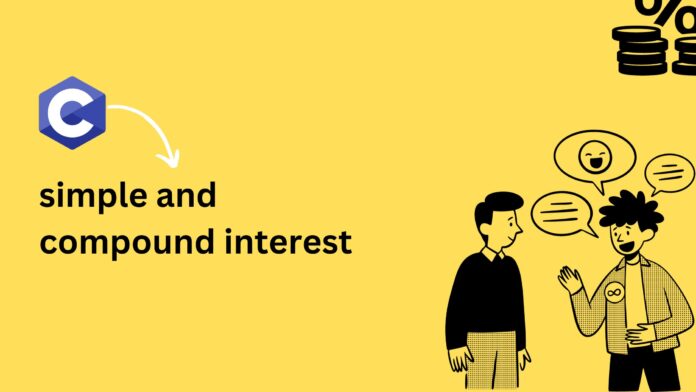Introduction
In the realm of finance and mathematics, understanding the concepts of simple and compound interest is fundamental. These concepts play a pivotal role in various financial calculations, and in this blog post, we will delve into creating a C program that calculates both simple and compound interest. Whether you are a programming enthusiast or someone looking to strengthen their grasp of financial calculations, this guide will walk you through the entire process, step by step.
The C Program: Finding Simple and Compound Interest
Simple Interest
Let’s start by examining how to calculate simple interest. Simple interest is calculated using the formula:
![]()
where:
- (P) is the principal amount,
- (R) is the rate of interest, and
- (T) is the time in years.
The Code: Calculating Simple Interest
#include <stdio.h>
int main() {
// Declare variables
float principal, rate, time, simple_interest;
// Input principal, rate, and time
printf("Enter the principal amount: ");
scanf("%f", &principal);
printf("Enter the rate of interest: ");
scanf("%f", &rate);
printf("Enter the time in years: ");
scanf("%f", &time);
// Calculate simple interest
simple_interest = (principal * rate * time) / 100;
// Display the result
printf("Simple Interest: %f\n", simple_interest);
return 0;
}Understanding the Code
- We declare variables for the principal amount, rate, time, and simple interest.
- User input is taken for principal, rate, and time.
- The simple interest is calculated using the provided formula.
- The result is displayed on the screen.
Compound Interest
Moving on to compound interest, it involves a bit more complexity. The compound interest formula is given by:
![]()
where the terms are the same as in the simple interest formula.
The Code: Calculating Compound Interest
#include <stdio.h>
#include <math.h>
int main() {
// Declare variables
float principal, rate, time, compound_interest;
// Input principal, rate, and time
printf("Enter the principal amount: ");
scanf("%f", &principal);
printf("Enter the rate of interest: ");
scanf("%f", &rate);
printf("Enter the time in years: ");
scanf("%f", &time);
// Calculate compound interest
compound_interest = principal * pow((1 + rate / 100), time) - principal;
// Display the result
printf("Compound Interest: %f\n", compound_interest);
return 0;
}Understanding the Code
- We include the
math.hheader for thepowfunction, which is used to calculate powers. - Similar to the simple interest code, user input is taken for principal, rate, and time.
- The compound interest is calculated using the compound interest formula.
- The result is displayed on the screen.
Breaking Down the Problem
Understanding the problem is crucial before diving into the code. Simple interest is straightforward – it’s a linear calculation based on the principal, rate, and time. Compound interest, on the other hand, involves the compounding effect over time. Breaking down the problem into smaller components helps in developing a clearer approach to the solution.
Breaking Down the Code: Step by Step
Step 1: Variable Declaration
In both programs, we start by declaring the necessary variables. These include the principal amount, rate of interest, time, and the variables to store the calculated interest.
float principal, rate, time, simple_interest;Step 2: User Input
We then take user input for the principal, rate, and time using the scanf function.
printf("Enter the principal amount: ");
scanf("%f", &principal);
printf("Enter the rate of interest: ");
scanf("%f", &rate);
printf("Enter the time in years: ");
scanf("%f", &time);Step 3: Calculation
For simple interest, we use the formula directly to calculate the interest.
simple_interest = (principal * rate * time) / 100;For compound interest, we utilize the pow function to calculate the compounding effect.
compound_interest = principal * pow((1 + rate / 100), time) - principal;Step 4: Display Result
Finally, we display the calculated interest on the screen.
printf("Simple Interest: %f\n", simple_interest);or
printf("Compound Interest: %f\n", compound_interest);Advanced Code: Adding Error Handling and Using Functions
To enhance our program, let’s introduce error handling and modularize the code by using functions.
Advanced Code: Error Handling
Error handling ensures that the user inputs valid values. We can achieve this by checking whether the entered values are non-negative.
// Validate user input for principal, rate, and time
if (principal < 0 || rate < 0 || time < 0) {
printf("Error: Please enter non-negative values for principal, rate, and time.\n");
return 1; // Exit the program with an error code
}Advanced Code: Using Functions
Modularization improves code readability and reusability. We can encapsulate the interest calculation logic in separate functions.
// Function to calculate simple interest
float calculateSimpleInterest(float principal, float rate, float time) {
return (principal * rate * time) / 100;
}
// Function to calculate compound interest
float calculateCompoundInterest(float principal, float rate, float time) {
return principal * pow((1 + rate / 100), time) - principal;
}In the main function, we can then call these functions.
// Calculate and display simple interest
simple_interest = calculateSimpleInterest(principal, rate, time);
printf("Simple Interest: %f\n", simple_interest);
// Calculate and display compound interest
compound_interest = calculateCompoundInterest(principal, rate, time);
printf("Compound Interest: %f\n", compound_interest);Conclusion
In this comprehensive guide, we explored the intricacies of calculating simple and compound interest using C programming. We began by understanding the basic formulas and then implemented the corresponding C code. Breaking down the problem and the code into manageable steps provides a structured approach to problem-solving. Additionally, we enhanced the code by introducing error handling and modularization through functions, demonstrating advanced programming practices.
By following this guide, you not only gained insights into financial calculations but also learned valuable programming techniques. As you continue your coding journey, applying these concepts to real-world scenarios will further hone your skills. Happy coding!


